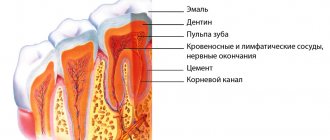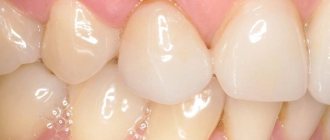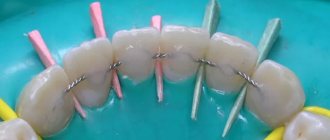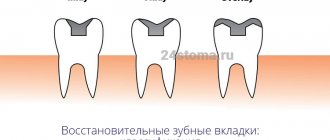Author of the article:
Soldatova Lyudmila Nikolaevna
Candidate of Medical Sciences, Professor of the Department of Clinical Dentistry of the St. Petersburg Medical and Social Institute, Chief Physician of the Alfa-Dent Dental Clinic, St. Petersburg
Drinking coffee and tea, smoking are the reasons for the formation of areas of enamel staining. The love of sweets, juices, fruits, combined with improper oral care, also leads to the fact that the enamel suffers: areas of demineralization, sensitivity, and caries appear. How to get rid of such unpleasant phenomena as dark pigment on teeth and sensitive enamel?
For this purpose, many different preparations are produced in the form of special toothpastes, gels, and varnishes. Let's talk about dental varnishes and alternative products. Some solve cosmetic problems and are intended for home use, others are used for therapeutic purposes and are applied by a doctor.
Types of dental varnishes for teeth
Whitening cosmetic varnishes
Professional whitening, which is offered by dental clinics, has one drawback - high cost. But there are options on how to achieve the effect of a “Hollywood” smile at minimal cost. Teeth enamel whitening varnish will help with this.
It makes teeth white from the first application, brightening them by at least 10 shades and giving a glossy shine. Products from different manufacturers may differ in the degree of whiteness and duration of action, but on average, one coat of teeth with varnish is enough for a maximum of a day. The principle of action is similar to nail polishes: the teeth are temporarily stained and, as a result, become whiter.
After the composition dries, a white film coating forms on the teeth, which can be easily removed with a toothbrush if desired, but can also be easily removed along with solid foods and drinks. The effect of whitening varnish-paint does not affect your own enamel; it will not relieve tooth sensitivity, if any.
The coating can be applied to restorations: on fillings, veneers, and crowns, it will have the same properties as on regular teeth.
The composition of different teeth whitening varnishes may vary, but some components are present in all products:
- film former;
- coloring component.
With repeated use, such varnishes can lighten your own tooth enamel by several tones. Manufacturers assure that, in addition to coloring, such varnishes have a remineralizing effect due to a special additive (hydroxyapatite), that is, they help restore and strengthen tooth enamel. In addition, the film has antiseptic and bactericidal properties, thus, while present on the teeth, it protects them from cervical caries.
Main indications for the use of whitening varnish:
- pigment spots on enamel;
- darkening of enamel from tobacco, coloring foods and drinks;
- difference in color of fillings and crowns.
Teeth whitening varnishes are good as a temporary solution, for example, for photo shoots, special events or public appearances when you need to look perfect. Safety: whitening varnishes do not contain acetone and other chemically hazardous components, therefore they do not damage tooth enamel and mucous membranes, and do not cause discomfort during application and presence in the mouth.
Note that whitening varnishes are not effective for problems such as moderate and severe forms of fluorosis, enamel hypoplasia, severe chips: in this case, tooth defects cannot be masked with several layers of varnish. With such defects, only ceramic restoration can improve the aesthetics.
Fluoride varnishes
Fluoridation is a procedure that is performed in a dental office. Goes in combination with professional oral hygiene.
When areas of enamel demineralization appear on a tooth, it becomes sensitive: it reacts to cold, hot, acidic foods and drinks. Dentists use fluoride preparations that seal open dentinal tubules, eliminating increased sensitivity.
Problems that fluoride varnish solves:
- decreased enamel sensitivity;
- prevention of caries;
- preventing further development of caries when it is at the spot stage.
Unlike whitening varnishes, fluoride varnishes are absolutely transparent on the teeth and do not have a whitening effect, but due to the preliminary removal of soft and hard plaque from the teeth during professional hygiene, the enamel is slightly lightened. Fluoride varnish creates a colorless protective film on the tooth surface that prevents the harmful effects of bacteria.
Fluoride-containing preparations are not applied to crowns, veneers, or dentures. It is recommended to begin fluoridation procedures in childhood, from the moment the baby teeth erupt, as this will protect the rudiments of permanent teeth. Fluoridation is also carried out for pregnant women, since the drugs are safe and do not have a negative impact on the health of a woman expecting the birth of a child. Fluoridation is especially recommended after removal of braces and clinical whitening.
The composition of fluoride varnish includes:
- sodium fluoride;
- chloroform;
- shellac;
- ethanol;
- fir resin.
Many have heard about the dangers of fluoride, and we have already talked about the consequences of its excess in the body. Dentists agree that the use of toothpastes with fluoride at a certain concentration of this element has a bad effect on tooth enamel and on health in general, especially if there is an increased content of fluoride in drinking water in a given region. But the concentration of fluorides in fluoride varnish is very small and cannot harm dental health. Therefore, fluoridation is recommended for the population even in regions with high fluoride content in water.
Remineralizing varnishes for children
Children's dental varnishes for remineralization can be distinguished into a separate category. Varnishes for children's teeth are available in various flavors, so that the little patient has a pleasant impression of visiting the doctor, and he does not feel afraid of the necessary medical procedures. The products contain xelitol, which allows you to fight pathogenic bacteria in the oral cavity some time after application.
Treatment of hypersensitivity of teeth with the drug “Dentin-sealing liquid”
Increased tooth sensitivity brings a lot of discomfort. The lesion may affect one or all teeth at once. The enamel becomes sensitive to hot and cold water, sour, sweet. Even just cool air when inhaling can cause pain. The dentists of our clinic will help you carry out high-quality diagnostics and prescribe effective treatment, regardless of the cause of this problem.
Treatment may include a whole range of measures, such as: adjustments to oral care, recommendations on how and with what to rinse teeth, treatment of the crowns of teeth with a special gel, advice on using a certain toothpaste, etc. For deeper carious lesions or cracks, it may be necessary to treat the tooth at the site of enamel damage with a filling.
In many cases, the drug “Dentin-sealing liquid” shows an excellent effect. It helps restore hard tooth tissues and prevents the development of caries. Recommended as a cushioning material when installing ceramic and other types of fillings. It has powerful antibacterial properties, as it contains copper ions. The bactericidal property makes it possible to maintain the sterility of dentin and enamel under restoration for a long time.
The drug has received many positive reviews from dentists around the world.
The sealing liquid consists of two bottles with different compositions. They are used as follows:
- the surface or cavity of the cleaned tooth (stump) is degreased and dried;
- apply composition No. 1;
- excess product is removed with a swab and dried if necessary;
- apply composition No. 2 (shake thoroughly before application);
- Next, a filling is applied.
Composition No. 2 contains a lot of calcium, which “seals” dentin, replacing damaged tooth enamel. Our clinic actively uses this drug in treatment. We will help you restore your teeth and restore the ability to eat sweet, sour, and cold foods without discomfort. Make an appointment with our specialists right now! Contacts are on the website.
How to use
Instructions for applying teeth whitening varnish
- The varnish should not be applied to the damp surface of the teeth, as it will not adhere to the enamel. Before applying the varnish, you need to clean and dry the surface with a napkin or cotton pad.
- Some manufacturers add a retractor to their whitening kit. If available, place it in the mouth.
- Shake the bottle before use.
- The varnish is applied in a thin layer to the surface of the tooth in the direction from the gums to the cutting edge.
- Wait the recommended time for the polish to dry without covering your mouth. If necessary, apply a second coat of varnish until the enamel is completely covered.
Teeth whitening varnish can be treated at least every day.
Algorithm for applying fluoride varnish
- The working field is isolated from the adjacent surfaces of the lips.
- The surface of the teeth is dried with a cotton swab.
- The doctor coats the teeth front and back with fluoride varnish using a special brush or applicator. The number of applications is determined by the dentist.
- The patient needs to sit with his mouth open for 5 minutes to fix the composition.
It is recommended to carry out fluoridation in the dentist's office 2 times a year.
Alternatives to Remineralizing and Whitening Teeth Varnishes
Various gels, foams and toothpastes are actively used in dentistry to remineralize teeth. Moreover, remineralizing gels and pastes can be used at home. For example, ASEPTA PLUS Remineralization toothpaste with hydroxyapatite, plant extracts, papain and thermal mud helps strengthen teeth and gums and reduces sensitivity. This paste should be used as usual: twice a day for 3 minutes.
Gels for remineralization at home are used in courses. The gel is applied with a toothbrush or finger to all surfaces of the teeth, cleaned of plaque, and left for the time specified in the instructions. Such products can be used in conjunction with universal mouth guards. Remineralizing gels are safe if accidentally swallowed. Their use is indicated after professional cleaning procedures.
For whitening, you can choose a special toothpaste. The effect of its use is cumulative and long-lasting, unlike whitening varnishes for home use, but less pronounced. Professional whitening pastes allow you to lighten the enamel by several tones. Particularly noticeable results are achieved in conjunction with professional teeth cleaning. For effective and safe enamel whitening, we recommend ASEPTA Gentle Whitening toothpaste. The fluoride-free paste contains fine abrasive components that clean the enamel of plaque without leaving microcracks. ASEPTA toothpaste prevents the occurrence of caries and sensitivity.
Interesting products for teeth whitening at home - strips, foam, gel stick. Sticky whitening strips absorb and break down dark pigments and plaque from the surface of teeth, resulting in a lighter natural shade of teeth. You will get visible results within 7 days of regular use of the strips, the maximum effect is achieved within 14 days.
Additional oral care in the form of whitening foam is intended for hygiene throughout the day. Recommended use after every meal. Thick foam breaks down soft plaque even in the most difficult to reach areas, without the need for a toothbrush or water. The active components of the product act on the surface of the enamel and penetrate into its deeper layers, discoloring coloring pigments. Additionally, the product helps strengthen tooth enamel and reduce sensitivity. This is the best option for those who wear braces or other orthodontic structures.
A whitening gel pencil can lighten teeth by 2-4 shades within a week of use. The use of individual trays improves the result, since the gel must be kept on the teeth for 5–7 minutes.
DENTIN-VERSIEGELUNSLIQUID for the prevention of caries, relieving dentin sensitivity, protecting pulp and dentin when filling cavities, covering teeth with crowns
Indications for use:
- desensitization of the tooth neck
- local prevention and treatment of dental caries
- mineral fissure sealing.
Properties: Enamel-sealing liquid in combination with calcium copper hydroxide, when applied sequentially, provides deep fluoridation of tooth enamel or bone cement of the tooth neck.
By deep fluoridation, in contrast to conventional fluoridation, we mean the formation of submicroscopic CaF2 crystals (50 A) in the pores of the loosened zone of the hard substance of the tooth. This occurs spontaneously after applying first enamel-sealing fluid and then copper-calcium hydroxide to the enamel or bone cement. As a result of the reaction between these substances, silicic acid is also formed.
CaF2 crystals, packed in silicic acid in funnels about 7µ deep and thereby protected from mechanical stress (for example, when chewing food), create an optimal environment of fluoride ions, which, together with mineral salts of saliva and enamel-sealing fluid, provide long-term remineralization of 100 times more effective than other fluoride-containing drugs.
When fluoridating with other drugs, such as sodium fluoride or amine fluoride, a reaction first occurs with the calcium of the tooth substance, which naturally has an adverse effect on the condition of the enamel. As a result of this reaction, relatively large CaF2 crystals are formed, which are not able to penetrate deep into the funnels. They remain on the enamel surface for a very short time, are quickly removed due to mechanical influences and therefore cannot have a significant effect on the remineralization processes.
Enamel-sealing liquid, unlike simple fluorides, such as sodium fluoride, does not have a toxic effect due to the sequential application of drugs (enamel-sealing liquid and copper-calcium hydroxide).
Directions for use:
Desensitization of the tooth neck: After removing plaque from the tooth neck with a brush and thoroughly drying it with warm air, the neck is generously moistened for 1/2 minute with a cotton swab soaked in enamel-sealing liquid. After this, without performing an intermediate rinse, the neck of the tooth is also thoroughly moistened with copper-calcium hydroxide. Only after this can you rinse. After repeating twice in 1-3 weeks, the procedure is subsequently carried out 1-2 times a year.
Prevention of caries through deep fluoridation (mineral sealing of enamel):
Teeth cleaned with a toothbrush (including the interdental space), after relative drying with warm air using a blower or suction, are treated quadrantly, that is, they are abundantly moistened with enamel-sealing liquid using a swab soaked in it.
Then, without rinsing, moisten it generously with copper-calcium hydroxide (also using a cotton swab). After this, you can rinse your mouth.
Carry out the procedure 1-2 times a year.
Mineral sealing of fissures: The fissures are pre-cleaned, minimally removing the hard substance, dried with warm air and thoroughly moistened with preparations, as in the prevention of caries.
With this technology, fissures that are usually coated with synthetic substances are coated with a mineral substance (hydrous silica).
Enamel-sealing liquid allows for highly effective mineral sealing of fissures, preserving tooth tissue as much as possible. The sealing is due to powerful remineralization with the participation of saliva as a result of deep fluoridation and the oligodynamic action of traces of copper.
In the future, the procedure is repeated once a year as part of caries prevention through deep fluoridation.
Note:
If you accidentally swallow a large amount of enamel sealing liquid (more than 5 ml), it is recommended to drink water or milk.
Your doctor's office may recommend using liquid gypsum milk (1 teaspoon per 1 glass of water) as an antidote.
Contraindications and side effects: none
Clinical researches
ASEPTA series toothpastes are distinguished by clinically proven effectiveness:
- Clinical studies have proven that regular use of professional toothpaste ASEPTA REMINERALIZATION improved the condition of the enamel by 64% and reduced tooth sensitivity by 66% after just 4 weeks.
- Clinical studies have proven that regular use of professional toothpaste ASEPTA GENTLE WHITENING for a month allows you to lighten tooth enamel by 1.5 tones, increases anti-caries effectiveness by 3.4 times and increases enamel remineralization by 2.6 times.
Sources:
- Report on the determination/confirmation of the preventive properties of personal oral hygiene products “ASEPTA PLUS” Remineralization doctor-researcher A.A. Leontyev, head Department of Preventive Dentistry, Doctor of Medical Sciences, Professor S.B. Ulitovsky First St. Petersburg State Medical University named after. acad. I.P. Pavlova, Department of Preventive Dentistry
- Report on determining/confirming the preventive properties of toothpaste “ASEPTA PLUS” GENTLE WHITENING” Author: doctor-researcher A.A. Leontyev, head Department of Preventive Dentistry, Doctor of Medical Sciences, Professor S.B. Ulitovsky First St. Petersburg State Medical University named after. acad. I.P. Pavlova, Department of Preventive Dentistry
- Characteristics of hard dental tissues in chronic kidney disease: morphology, chemical composition, possibilities of remineralizing therapy Doctor of Medical Sciences, Prof. A.K. YORDANISHVILI [1—3], Ph.D. O.A. BELSKIKH [2], MD. O.L. PIKHUR [4] 1. Northwestern State Medical University named after. I.I. Mechnikova, St. Petersburg, Russia; 2. Military Medical Academy named after. CM. Kirova, St. Petersburg, Russia; 3. Medical and Social Institute, St. Petersburg, Russia 4. Institute of Bioregulation and Gerontology, St. Petersburg, Russia








